Contrasting Effects of Tectonic Faults on Vegetation Growth along the Elevation Gradient in Tectonically Active Mountains
Abstract
:1. Introduction
2. Materials and Methods
2.1. Study Area
2.2. Data and Processing
2.3. Analysis Methods
2.3.1. Derivation of the Effect of the Individual Factor by the Boundary Line Approach
2.3.2. Correlation and Trend Analysis
3. Results
3.1. Spatial Distribution of Faults
3.1.1. Fault Length Density
3.1.2. Variation of FLD with Elevation
3.2. NDVI Variations
3.2.1. Spatio-Temporal Patterns of NDVI
3.2.2. Relationship between NDVI Variation and Elevation
3.3. Elevation-Dependent Relationship between NDVI Variation and FLD
4. Discussion
4.1. Elevational Patterns of Vegetation Growth and Its Links with Tectonic Faults
4.2. Temporal Variations of Vegetation Growth
4.3. Elevation-Dependent Contrasting Effects of Fault Distribution on Vegetation Growth
5. Conclusions
Author Contributions
Funding
Data Availability Statement
Acknowledgments
Conflicts of Interest
Appendix A

References
- Gao, W.; Zheng, C.; Liu, X.; Lu, Y.; Chen, Y.; Wei, Y.; Ma, Y. NDVI-based vegetation dynamics and their responses to climate change and human activities from 1982 to 2020: A case study in the Mu Us Sandy Land, China. Ecol. Indic. 2022, 137, 108745. [Google Scholar] [CrossRef]
- Chen, Z.; Wang, W.; Fu, J. Vegetation response to precipitation anomalies under different climatic and biogeographical conditions in China. Sci. Rep. 2020, 10, 830. [Google Scholar] [CrossRef] [PubMed]
- Sun, G.; Li, L.; Li, J.; Liu, C.; Wu, Y.; Gao, S.; Wang, Z.; Feng, G. Impacts of climate change on vegetation pattern: Mathematical modelling and data analysis. Phys. Life Rev. 2022, 42, 239–270. [Google Scholar] [CrossRef] [PubMed]
- Wang, J.; Hu, A.; Meng, F.; Zhao, W.; Yang, Y.; Soininen, J.; Shen, J.; Zhou, J. Embracing mountain microbiome and ecosystem functions under global change. New Phytol. 2022, 234, 1987–2002. [Google Scholar] [CrossRef] [PubMed]
- Antonelli, A.; Kissling, W.D.; Flantua, S.A.; Bermúdez, M.A.; Mulch, A.; Muellner-Riehl, A.N.; Kreft, H.; Linder, H.P.; Badgley, C.; Fjeldså, J.; et al. Geological and climatic influences on mountain biodiversity. Nat. Geosci. 2018, 11, 718–725. [Google Scholar] [CrossRef]
- Dong, Y.; Shi, X.; Sun, S.; Sun, J.; Hui, B.; He, D.; Chong, F.; Yang, Z. Co-evolution of the Cenozoic tectonics, geomorphology, environment and ecosystem in the Qinling Mountains and adjacent areas, Central China. Geosyst. Geoenviron. 2022, 1, 100032. [Google Scholar] [CrossRef]
- Dong, X.; Martin, J.B.; Cohen, M.J.; Tu, T. Bedrock mediates responses of ecosystem productivity to climate variability. Commun. Earth Environ. 2023, 4, 114. [Google Scholar] [CrossRef]
- Graham, R.; Rossi, A.; Hubbert, R. Rock to regolith conversion: Producing hospitable substrates for terrestrial ecosystems. GSA today 2010, 20, 4–9. [Google Scholar] [CrossRef]
- Ding, W.; Ree, R.; Spicer, R.; Xing, Y. Ancient orogenic and monsoon-driven assembly of the world’s richest temperate alpine flora. Science 2020, 369, 578–581. [Google Scholar] [CrossRef]
- Hu, A.; Wang, J.; Sun, H.; Niu, B.; Si, G.; Wang, J.; Yeh, C.; Zhu, X.; Lu, X.; Zhou, J.; et al. Mountain biodiversity and ecosystem functions: Interplay between geology and contemporary environments. ISME J. 2020, 14, 931–944. [Google Scholar] [CrossRef]
- Fan, Y.; Clark, M.; Lawrence, D.; Swenson, S.; Band, L.E.; Brantley, S.; Brooks, P.; Dietrich, W.; Flores, A.; Grant, G.; et al. Hillslope hydrology in global change research and earth system modeling. Water Resour. Res. 2019, 55, 1737–1772. [Google Scholar] [CrossRef]
- Yang, J.; El-Kassaby, Y.A.; Guan, W. The effect of slope aspect on vegetation attributes in a mountainous dry valley, Southwest China. Sci. Rep. 2020, 10, 16465. [Google Scholar] [CrossRef] [PubMed]
- Dawson, T.E.; Hahm, W.J.; Crutchfield-Peters, K. Digging deeper: What the critical zone perspective adds to the study of plant ecophysiology. New Phytol. 2020, 226, 666–671. [Google Scholar] [CrossRef] [PubMed]
- Hahm, W.J.; Riebe, C.S.; Lukens, C.E.; Araki, S. Bedrock composition regulates mountain ecosystems and landscape evolution. Proc. Natl. Acad. Sci. USA 2014, 111, 3338–3343. [Google Scholar] [CrossRef] [PubMed]
- Hahm, W.J.; Rempe, D.M.; Dralle, D.N.; Dawson, T.E.; Dietrich, W.E. Oak transpiration drawn from the weathered bedrock vadose zone in the summer dry season. Water Resour. Res. 2020, 56, e2020WR027419. [Google Scholar] [CrossRef]
- Jiménez-Rodríguez, C.D.; Sulis, M.; Schymanski, S. Exploring the role of bedrock representation on plant transpiration response during dry periods at four forested sites in Europe. Biogeosciences 2020, 19, 3395–3423. [Google Scholar] [CrossRef]
- Ludat, A.L.; Kübler, S. Tectonic controls on the ecosystem of the Mara River basin, East Africa, from geomorphological and spectral index analysis. Biogeosciences 2023, 20, 1991–2012. [Google Scholar] [CrossRef]
- Shlemon, R.J.; Riefner, R.E. The Role of Tectonic Processes in the Interaction between Geology and Ecosystems, In Geology and Ecosystems, 1st ed.; Zektser, I.S., Marker, B., Ridgway, J., Rogachevskaya, L., Vartanyan, G., Eds.; Springer: Boston, MA, USA, 2006; pp. 49–60. [Google Scholar]
- Dixon, J.L.; Hartshorn, A.S.; Heimsath, A.M.; DiBiase, R.A.; Whipple, K.X. Chemical weathering response to tectonic forcing: A soils perspective from the San Gabriel Mountains, California. Earth Planet. Sci. Lett. 2012, 323, 40–49. [Google Scholar] [CrossRef]
- Veblen, T.T.; González, M.E.; Stewart, G.H.; Kitzberger, T.; Brunet, J. Tectonic ecology of the temperate forests of South America and New Zealand. N. Z. J. Bot. 2006, 54, 223–246. [Google Scholar] [CrossRef]
- Kübler, S.; Rucina, S.; Aßbichler, D.; Eckmeier, E.; King, G. Lithological and topographic impact on soil nutrient distributions in tectonic landscapes: Implications for Pleistocene human-landscape interactions in the southern Kenya Rift. Front. Environ. Sci. 2021, 9, 103. [Google Scholar] [CrossRef]
- Duan, Y.; Di, B.; Ustin, S.L.; Xu, C.; Xie, Q.; Wu, S.; Li, J.; Zhang, R. Changes in ecosystem services in a montane landscape impacted by major earthquakes: A case study in Wenchuan earthquake-affected area, China. Ecol. Indic. 2021, 126, 107683. [Google Scholar] [CrossRef]
- Reynolds, S.C.; Marston, C.G.; Hassani, H.; King, G.C.; Bennett, M.R. Environmental hydro-refugia demonstrated by vegetation vigour in the Okavango Delta, Botswana. Sci. Rep. 2016, 6, 35951. [Google Scholar] [CrossRef] [PubMed]
- Li, J.; Zhang, J.; Zhao, X.; Jiang, M.; Li, Y.; Zhu, Z.; Feng, Q.; Wang, L.; Sun, G.; Liu, J.; et al. Mantle subduction and uplift of intracontinental mountains: A case study from the Chinese Tianshan Mountains within Eurasia. Sci. Rep. 2016, 6, 28831. [Google Scholar] [CrossRef] [PubMed]
- Li, W.; Chen, Y.; Yuan, X.; Xiao, W.; Windley, B.F. Intracontinental deformation of the Tianshan Orogen in response to India-Asia collision. Nat. Commun. 2022, 13, 3738. [Google Scholar] [CrossRef] [PubMed]
- Yao, Y.; Wen, S.; Yang, L.; Wu, C.; Sun, X.; Wang, L.; Zhang, Z. A shallow and left-lateral rupture event of the 2021 Mw 5.3 Baicheng earthquake: Implications for the diffuse deformation of southern Tianshan. Earth Space Sci. 2022, 9, e2021EA001995. [Google Scholar] [CrossRef]
- Zhang, W.; Luo, G.; Chen, C.; Ochege, F.; Hellwich, O.; Zheng, H.; Hamdi, R.; Wu, S. Quantifying the contribution of climate change and human activities to biophysical parameters in an arid region. Ecol. Indic. 2021, 129, 107996. [Google Scholar] [CrossRef]
- Ni, X.; Wang, B.; Cluzel, D.; Liu, J.; He, Z. Late Paleozoic tectonic evolution of the North Tianshan Belt: New structural and geochronological constraints from meta-sedimentary rocks and migmatites in the Harlik Range (NW China). J. Asian Earth Sci. 2021, 210, 104711. [Google Scholar] [CrossRef]
- Li, Y.; Chen, Y.; Sun, F.; Li, Z. Recent vegetation browning and its drivers on Tianshan Mountain, Central Asia. Ecol. Indic. 2021, 129, 107912. [Google Scholar] [CrossRef]
- Tudi, M.; Li, H.; Li, H.; Wang, L.; Yang, L.; Tong, S.; Yu, Q.J.; Ruan, H.D. Evaluation of soil nutrient characteristics in Tianshan Mountains, North-western China. Ecol. Indic. 2022, 143, 109431. [Google Scholar] [CrossRef]
- Liu, X.; Yuan, S.; Bai, X.; Jiang, J.; Li, Y.; Liu, J. Tectonic uplift of the Tianshan Mountains since Quaternary: Evidence from magnetostratigraphy of the Yili Basin, northwestern China. Int. J. Earth Sci. 2023, 112, 855–865. [Google Scholar] [CrossRef]
- Luo, W.; Zhang, Z.; Duan, S.; Jiang, Z.; Wang, D.; Chen, J.; Sun, J. Geochemistry of the Zhibo submarine intermediate-mafic volcanic rocks and associated iron ores, Western Tianshan, Northwest China: Implications for ore genesis. Geol. J. 2018, 53, 3147–3172. [Google Scholar] [CrossRef]
- Shangguan, W.; Dai, Y.; Liu, B.; Zhu, A.; Duan, Q.; Wu, L.; Ji, D.; Ye, A.; Yuan, H.; Zhang, Q.; et al. A China Dataset of Soil Properties for Land Surface Modeling. J. Adv. Model. Earth Syst. 2013, 5, 212–224. [Google Scholar] [CrossRef]
- Liu, J.; Kuang, W.; Zhang, Z.; Xu, X.; Qin, Y.; Ning, J.; Zhou, W.; Zhang, S.; Li, R.; Yan, C.; et al. Spatiotemporal characteristics, patterns, and causes of land-use changes in China since the late 1980s. J. Geogr. Sci. 2014, 24, 195–210. [Google Scholar] [CrossRef]
- He, S.; Li, J.; Wang, J.; Liu, F. Evaluation and analysis of upscaling of different land use/land cover products (FORM-GLC30, GLC_FCS30, CCI_LC, MCD12Q1 and CNLUCC): A case study in China. Geocarto Int. 2022, 37, 17340–17360. [Google Scholar] [CrossRef]
- Li, H.; Luo, Y.; Sun, L.; Li, X.; Ma, C.; Wang, X.; Jiang, T.; Zhu, H. Modelling the artificial forest (Robinia pseudoacacia L.) root–soil water interactions in the Loess Plateau, China. Hydrol. Earth Syst. Sci. 2022, 26, 17–34. [Google Scholar] [CrossRef]
- Yang, W.; Wang, Y.; Webb, A.A.; Li, Z.; Tian, X.; Han, Z.; Wang, S.; Yu, P. Influence of climatic and geographic factors on the spatial distribution of Qinghai spruce forests in the dryland Qilian Mountains of Northwest China. Sci. Total. Environ. 2018, 612, 1007–1017. [Google Scholar] [CrossRef]
- Gao, X.; Huang, X.; Lo, K.; Dang, Q.; Wen, R. Vegetation responses to climate change in the Qilian Mountain Nature Reserve, Northwest China. Glob. Ecol. Conserv. 2021, 28, e01698. [Google Scholar] [CrossRef]
- Xiong, Y.; Wang, H. Spatial relationships between NDVI and topographic factors at multiple scales in a watershed of the Minjiang River, China. Ecol. Inform. 2022, 69, 101617. [Google Scholar] [CrossRef]
- Zou, L.; Tian, F.; Liang, T.; Eklundh, L.; Tong, X.; Tagesson, T.; Dou, Y.; He, T.; Liang, S.; Fensholt, R. Assessing the upper elevational limits of vegetation growth in global high-mountains. Remote Sens. Environ. 2023, 286, 113423. [Google Scholar] [CrossRef]
- Tai, X.; Epstein, H.E.; Li, B. Elevation and climate effects on vegetation greenness in an arid mountain-basin system of Central Asia. Remote Sens. 2020, 12, 1665. [Google Scholar] [CrossRef]
- Fu, J.X.; Cao, G.C.; Guo, W.J. Changes of growing season NDVI at different elevations, slopes, slope aspects and its relationship with meteorological factors in the southern slope of the Qilian Mountains, China from 1998 to 2017. J. Appl. Ecol. 2020, 31, 1203–1212, (In Chinese with English abstract). [Google Scholar] [CrossRef]
- Huang, C.; Yang, Q.; Guo, Y.; Zhang, Y.; Guo, L. The pattern, change and driven factors of vegetation cover in the Qin Mountains region. Sci. Rep. 2020, 10, 20591. [Google Scholar] [CrossRef] [PubMed]
- Zhang, Y.; Liu, L.Y.; Liu, Y.; Zhang, M.; An, C.B. Response of altitudinal vegetation belts of the Tianshan Mountains in northwestern China to climate change during 1989–2015. Sci. Rep. 2021, 11, 4870. [Google Scholar] [CrossRef] [PubMed]
- Wei, Y.; Lu, H.; Wang, J.; Wang, X.; Sun, J. Dual influence of climate change and anthropogenic activities on the spatiotemporal vegetation dynamics over the Qinghai-Tibetan plateau from 1981 to 2015. Earth’s Future 2022, 10, e2021EF002566. [Google Scholar] [CrossRef]
- Wei, Z.; He, H. Weathering history of an exposed bedrock fault surface interpreted from its topography. J. Struct. Geol. 2013, 56, 34–44. [Google Scholar] [CrossRef]
- Wang, Q.; Zhai, P.M.; Qin, D.H. New perspectives on ‘warming–wetting’ trend in Xinjiang, China. Adv. Clim. Chang. Res. 2020, 11, 252–260. [Google Scholar] [CrossRef]
- Yao, J.; Chen, Y.; Guan, X.; Zhao, Y.; Chen, J.; Mao, W. Recent climate and hydrological changes in a mountain–basin system in Xinjiang, China. Earth Sci. Rev. 2022, 226, 103957. [Google Scholar] [CrossRef]
- Zhang, W.; Luo, G.; Zheng, H.; Wang, H.; Hamdi, R.; HE, H.; Peng, C.; Chen, C. Analysis of vegetation index changes and driving forces in inland arid areas based on random forest model: A case study of the middle part of northern slope of the north Tianshan Mountains. Chin. J. Plant Ecol. 2020, 44, 1113–1126, (In Chinese with English abstract). [Google Scholar] [CrossRef]
- Zhu, M.; Zhang, J.; Zhu, L. Article title variations in growing season NDVI and its sensitivity to climate change responses to green development in mountainous areas. Front. Environ. Sci. 2021, 9, 678450. [Google Scholar] [CrossRef]
- Huang, X.; Luo, G.; He, H.; Wang, X.; Amuti, T. Ecological effects of grazing in the northern Tianshan Mountains. Water 2017, 9, 932. [Google Scholar] [CrossRef]
- Yang, Y.; Fan, X.; Wang, X.; Lv, L.; Zou, C.; Feng, Z. Net primary productivity changes associated with landslides induced by the 2008 Wenchuan Earthquake. Land Degrad. Dev. 2023, 34, 1035–1050. [Google Scholar] [CrossRef]
- Allen, R.B.; MacKenzie, D.I.; Bellingham, P.J.; Wiser, S.K.; Arnst, E.A.; Coomes, D.A.; Hurst, J.M. Tree survival and growth responses in the aftermath of a strong earthquake. J. Ecol. 2020, 108, 107–121. [Google Scholar] [CrossRef]
- Yan, F.; Shangguan, W.; Zhang, J.; Hu, B. Depth-to-bedrock map of China at a spatial resolution of 100 meters. Sci. Data 2020, 7, 2. [Google Scholar] [CrossRef]
- Zou, Y.; Qi, S.; Guo, S.; Zheng, B.; Zhan, Z.; He, N.; Hou, X.; Liu, H. Factors controlling the spatial distribution of coseismic landslides triggered by the Mw 6.1 Ludian earthquake in China. Eng. Geol. 2022, 296, 106477. [Google Scholar] [CrossRef]
- Liang, S.; Qiao, H.; Lyu, D.; He, Q. Distribution characteristics and main controlling factors of geohazards in Ili Valley. Arid Land Geogr. 2023, 46, 880–888, (In Chinese with English abstract). [Google Scholar] [CrossRef]
- Molnar, P.; Anderson, R.S.; Anderson, S.P. Tectonics, fracturing of rock, and erosion. J. Geophys. Res. Earth. Surf. 2007, 112, F03014. [Google Scholar] [CrossRef]
- Brocard, G.; Willebring, J.; Scatena, F. Shaping of topography by topographically-controlled vegetation in tropical montane rainforest. PLoS ONE 2023, 18, e0281835. [Google Scholar] [CrossRef]
- Hoylman, Z.; Jencso, K.; Hu, J.; Martin, J.; Holden, Z.; Seielstad, C.; Rowell, E. Hillslope topography mediates spatial patterns of ecosystem sensitivity to climate. J. Geophys. Res. Biogeosci. 2018, 123, 353–371. [Google Scholar] [CrossRef]
- Swetnam, T.; Brooks, P.; Barnard, H.; Harpold, A.; Gallo, E. Topographically driven differences in energy and water constrain climatic control on forest carbon sequestration. Ecosphere 2017, 8, e01797. [Google Scholar] [CrossRef]
- Ding, C.; Li, Y.; Xie, Q.; Li, H.; Zhang, B. Impacts of terrain on land surface phenology derived from Harmonized Landsat 8 and Sentinel-2 in the Tianshan Mountains, China. GIsci. Remote Sens. 2023, 60, 2242621. [Google Scholar] [CrossRef]
- Wang, C.; Chen, J.; Chen, X.; Chen, J. Identification of concealed faults in a grassland area in Inner Mongolia, China, using the temperature vegetation dryness index. J. Earth Sci. 2019, 30, 853–860. [Google Scholar] [CrossRef]
- Wu, W.; Zou, L.; Shen, X.; Lu, S.; Su, N.; Kong, F.; Dong, Y. Thermal infrared remote-sensing detection of thermal information associated with faults: A case study in Western Sichuan Basin, China. J. Asian Earth Sci. 2012, 43, 110–117. [Google Scholar] [CrossRef]
- Jolie, E.; Scott, S.; Faulds, J.; Chambefort, I.; Axelsson, G.; Gutiérrez-Negrín, L.C.; Regenspurg, S.; Ziegler, M.; Ayling, B.; Richter, A.; et al. Geological controls on geothermal resources for power generation. Nat. Rev. Earth Env. 2023, 2, 324–339. [Google Scholar] [CrossRef]
- Hahm, W.; Rempe, D.; Dralle, D.; Dawson, T.; Lovill, S.; Bryk, A.; Bish, D.; Schieber, J.; Dietrich, W. Lithologically controlled subsurface critical zone thickness and water storage capacity determine regional plant community composition. Water Resour. Res. 2019, 55, 3028–3055. [Google Scholar] [CrossRef]
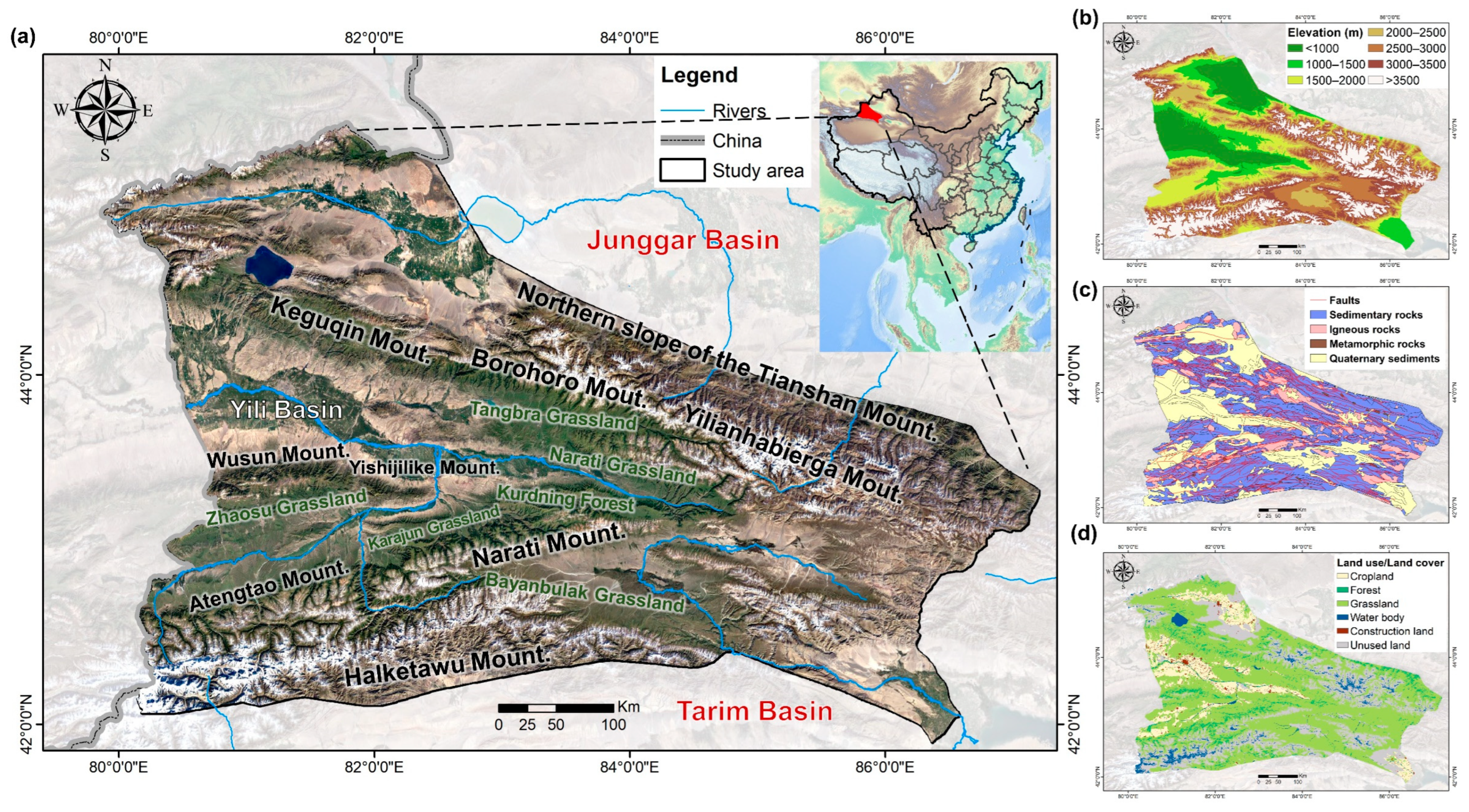

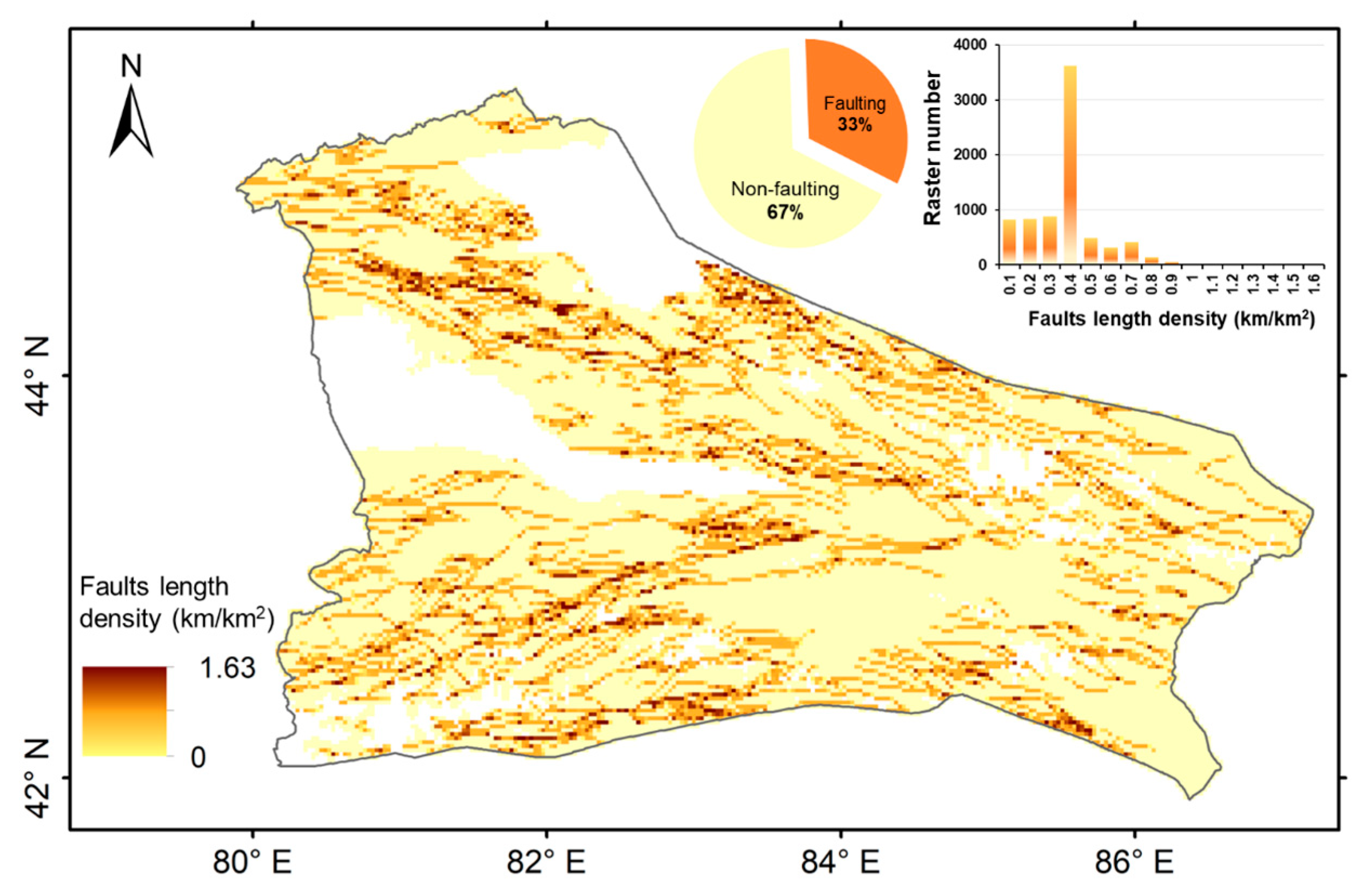


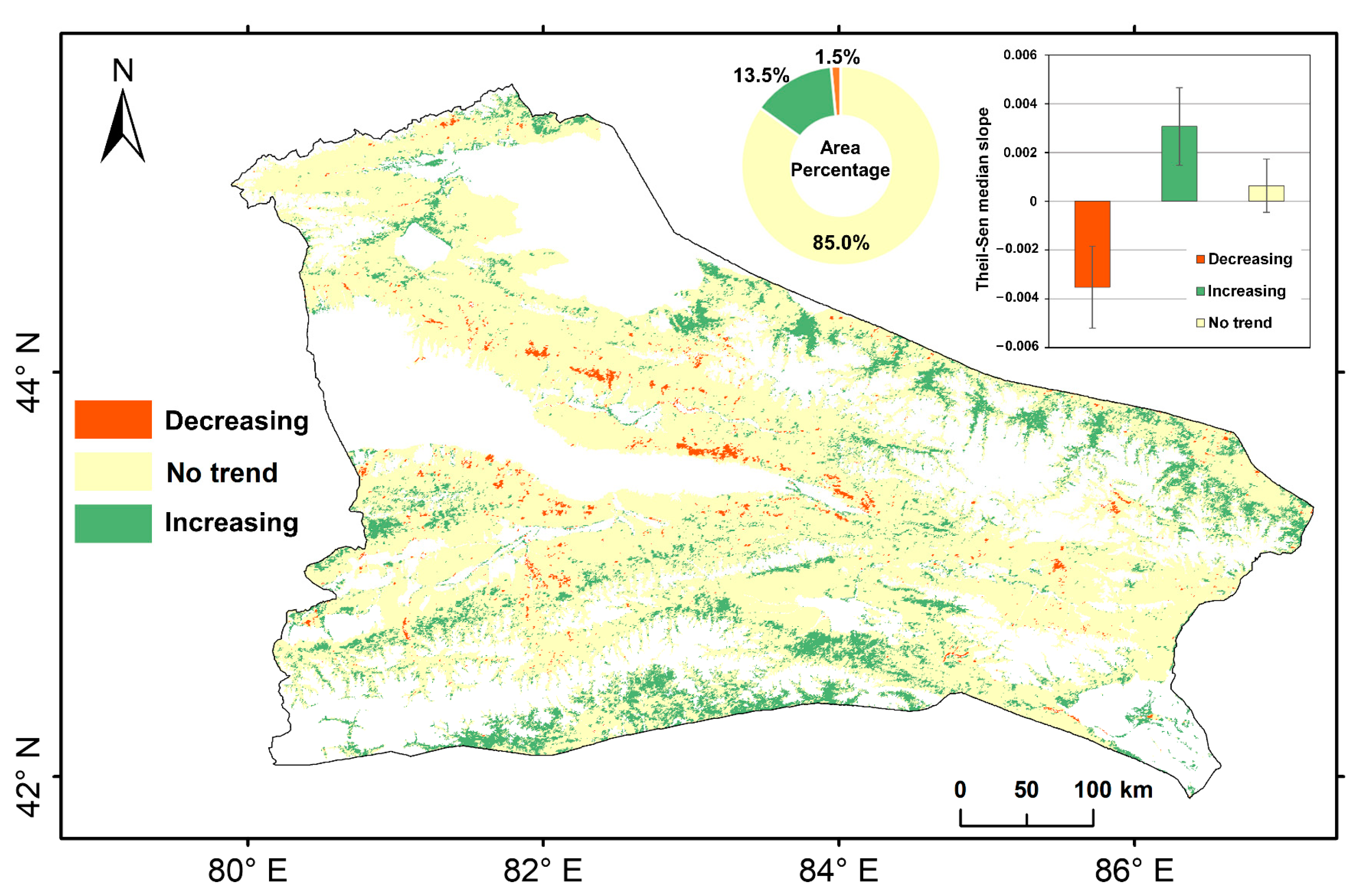
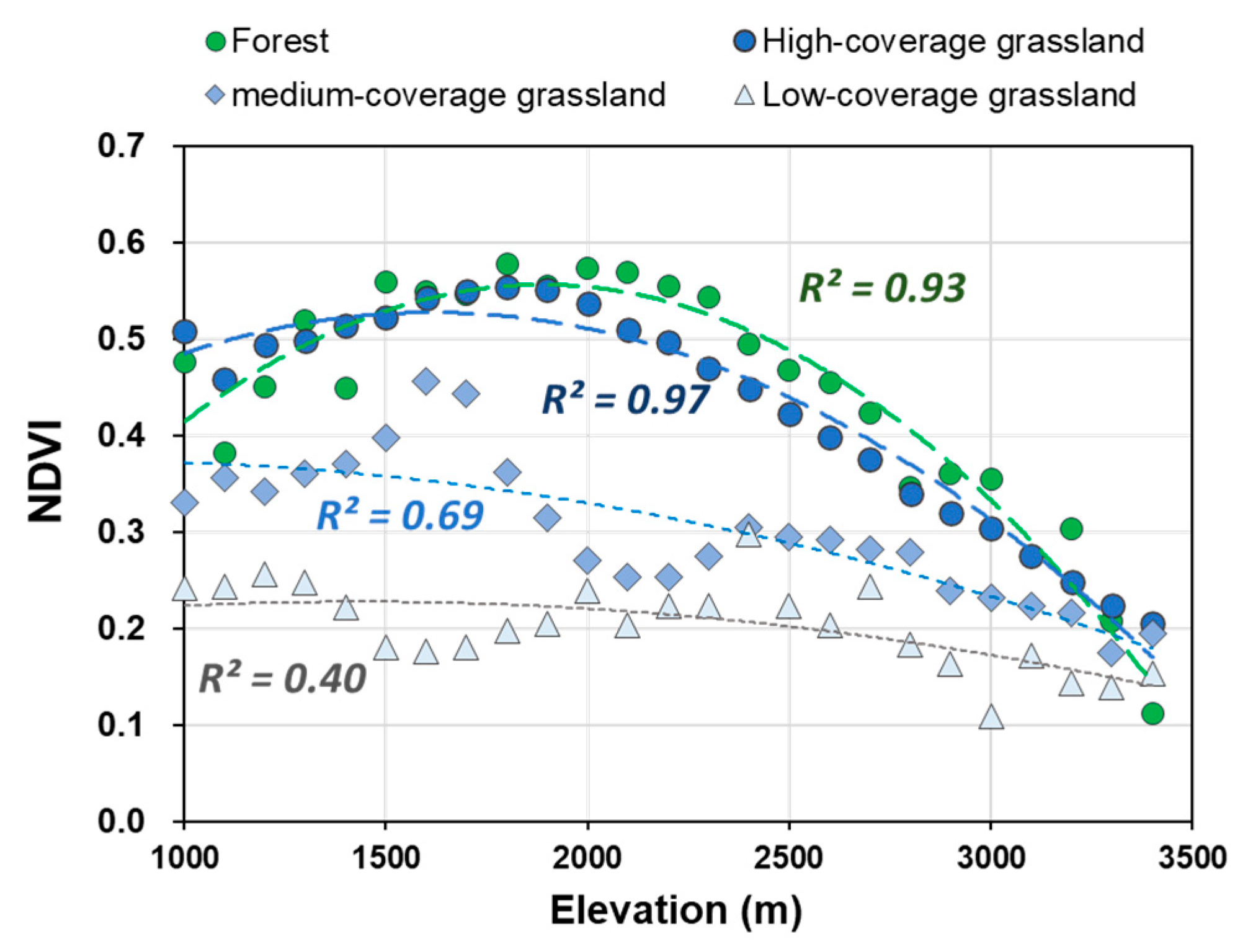

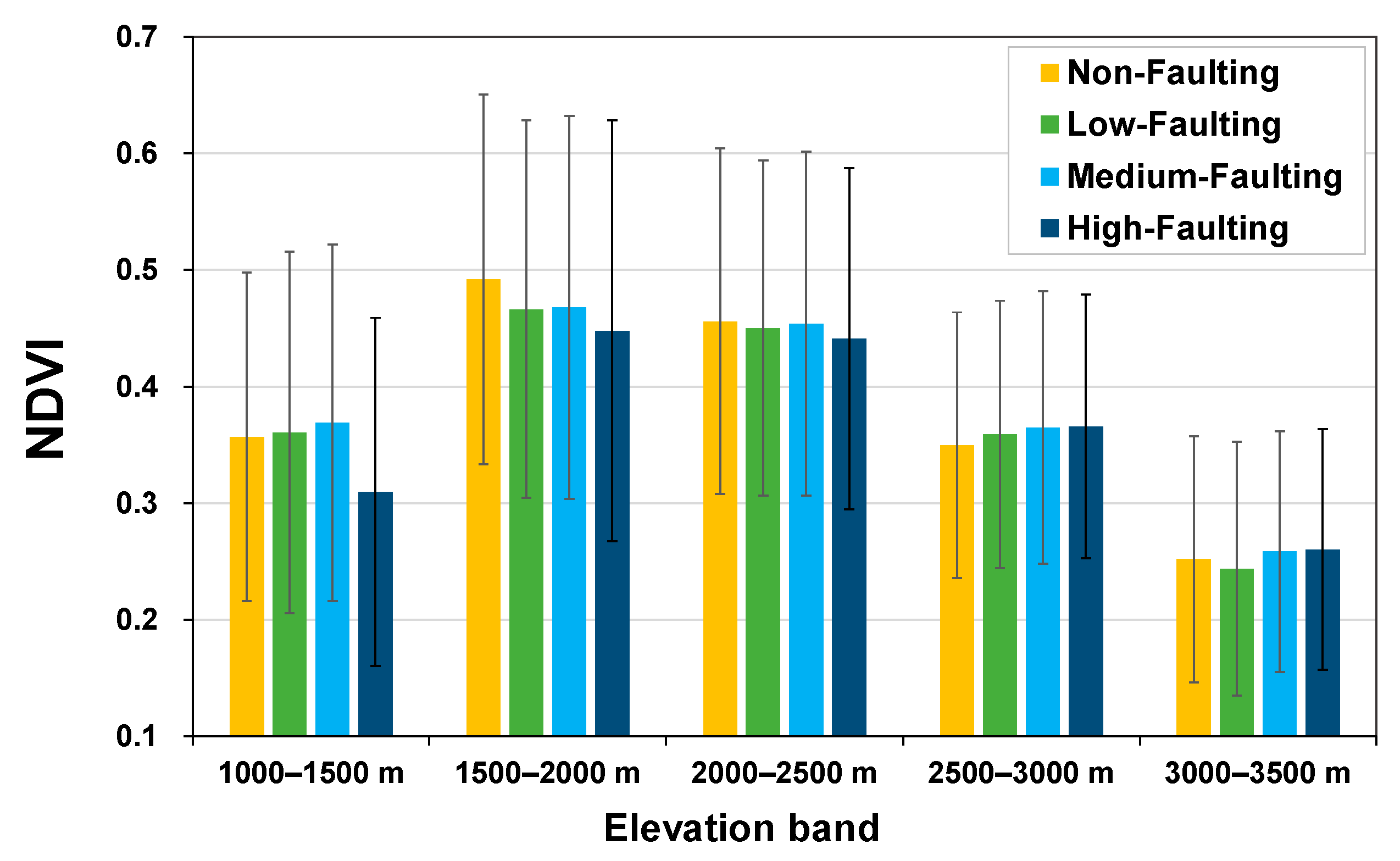
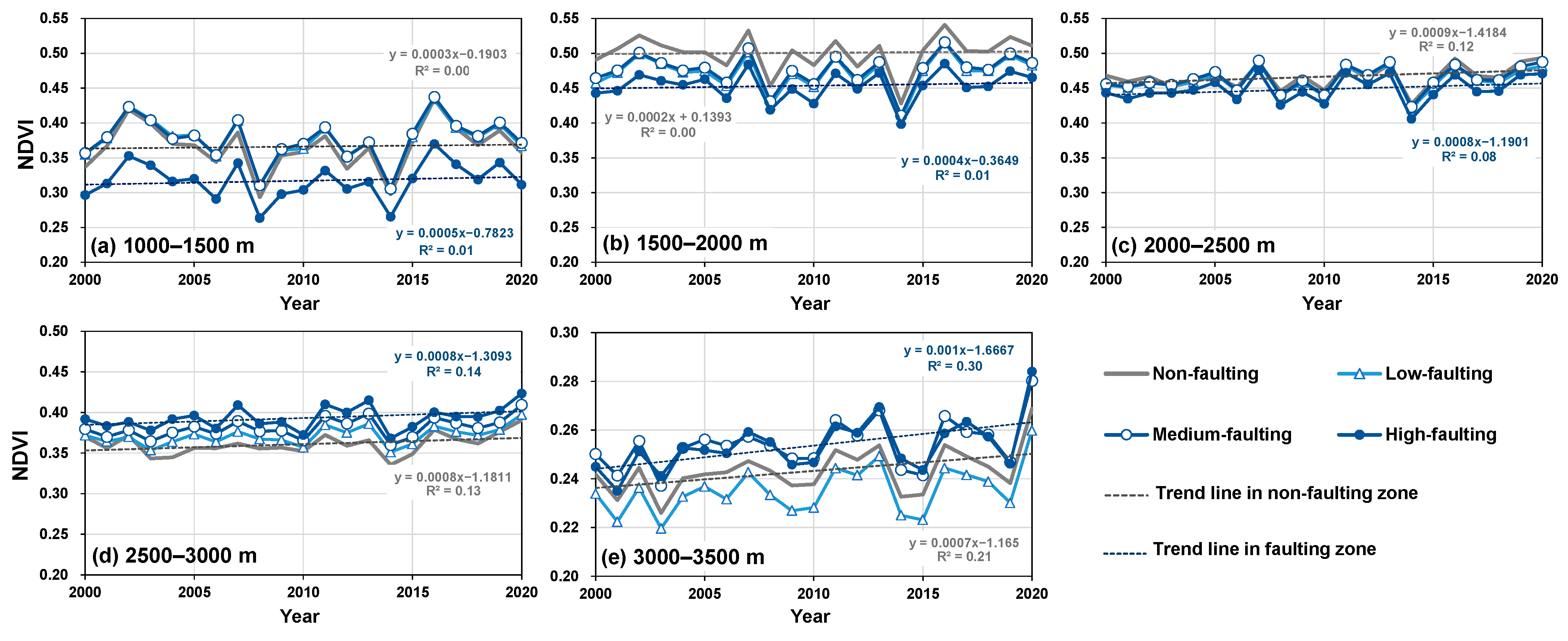
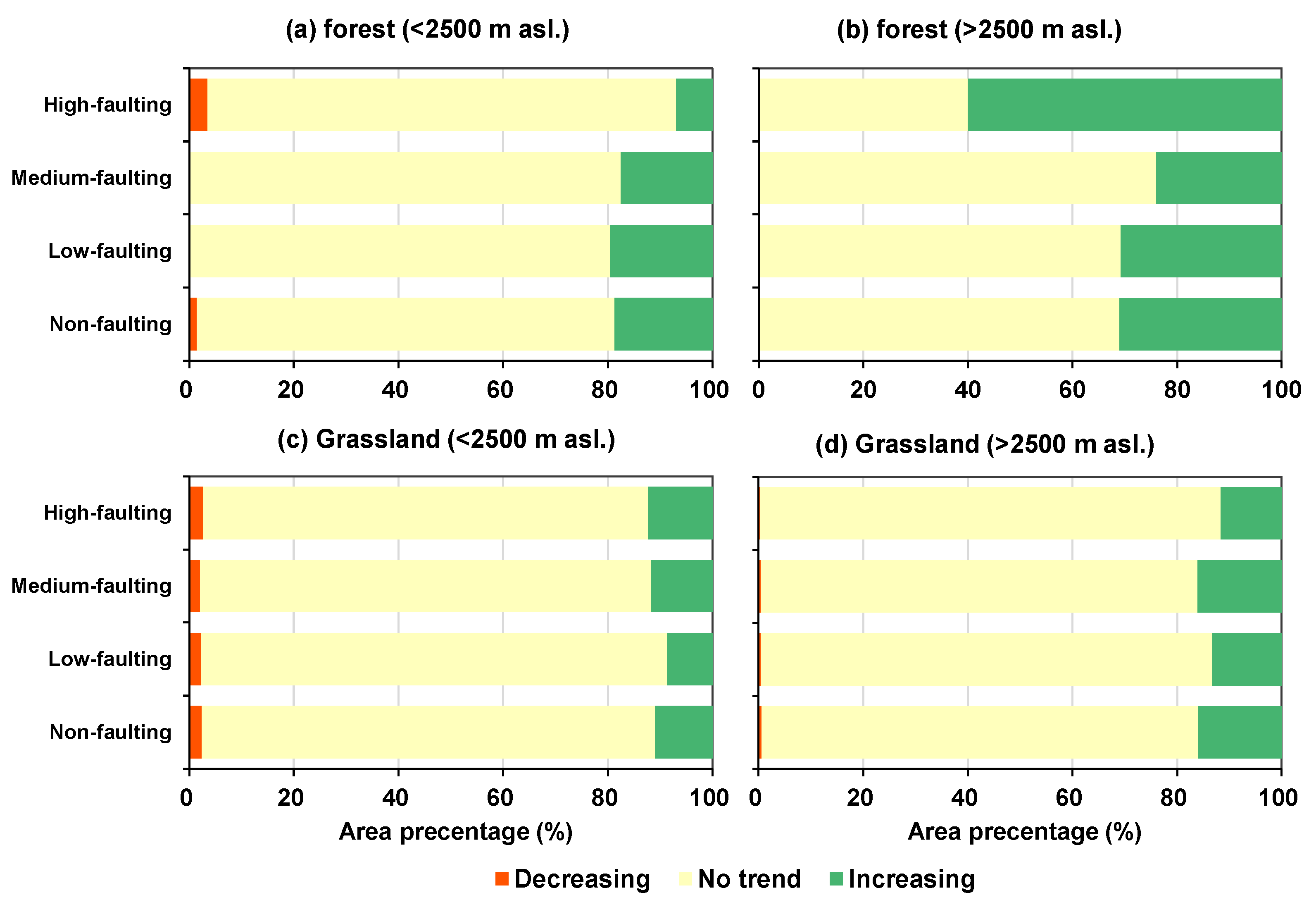
| Data | Data Type | Spatial Resolution | Temporal Range | Data Source |
|---|---|---|---|---|
| Faults (Spatial Database of 1:250,000 Digital Geologic Map of Xinjiang) | Line vector | - | - | GeoCloud3.0 (https://geocloud.cgs.gov.cn, accessed on 16 July 2023) |
| DEM (ASTER) | Raster | 90 m | - | Geospatial Data Cloud site (https://www.gscloud.cn/, accessed on 16 July 2023) |
| Soil depth (A China dataset of soil properties for land surface modeling) | Raster | 1000 m | - | A Big Earth Data Platform for Three Poles (https://poles.tpdc.ac.cn/, accessed on 23 July 2023) |
| Land Cover (China National Land Use and Cover Change dataset) | Raster | 1000 m | 2000, 2005, 2010, 2015, 2020 | Resources and Environmental Sciences Data Center (https://www.resdc.cn/, accessed on 30 June 2023) |
| NDVI (MOD13A2) | Raster | 500 m | 2000–2020 | Google Earth Engine (https://code.earthengine.google.com/, accessed on 7 July 2023) |
| Annual temperature and precipitation (ERA5, Latest Climate Reanalysis Produced by ECMWF) | Raster | 0.1° | 2000–2020 | Google Earth Engine (https://earthengine.google.com/, accessed on 20 July 2023) |
| NDVI Variation Type | Scales |
|---|---|
| Significant increase | , |
| Significant decrease | , |
| No trend |
| Faulting Class: Fault Length Density Range (km/km2) | Area (104 km2) | Area Percentage (%) | Average Fault Length Density (km/km2) | Average Elevation (m) |
|---|---|---|---|---|
| Non-faulting (0) | 13.2 | 66.9 | 0 | 2283 |
| Low-faulting (0–0.25) | 1.8 | 8.9 | 0.10 | 2361 |
| Medium-faulting (0.25–0.5) | 3.9 | 19.7 | 0.33 | 2427 |
| High-faulting (>0.5) | 0.9 | 4.4 | 0.59 | 2350 |
Disclaimer/Publisher’s Note: The statements, opinions and data contained in all publications are solely those of the individual author(s) and contributor(s) and not of MDPI and/or the editor(s). MDPI and/or the editor(s) disclaim responsibility for any injury to people or property resulting from any ideas, methods, instructions or products referred to in the content. |
© 2023 by the authors. Licensee MDPI, Basel, Switzerland. This article is an open access article distributed under the terms and conditions of the Creative Commons Attribution (CC BY) license (https://creativecommons.org/licenses/by/4.0/).
Share and Cite
Li, H.; Liu, X.; Zhao, X.; Zhang, W.; Liu, J.; Luo, X.; Wang, R.; Xing, L. Contrasting Effects of Tectonic Faults on Vegetation Growth along the Elevation Gradient in Tectonically Active Mountains. Forests 2023, 14, 2336. https://doi.org/10.3390/f14122336
Li H, Liu X, Zhao X, Zhang W, Liu J, Luo X, Wang R, Xing L. Contrasting Effects of Tectonic Faults on Vegetation Growth along the Elevation Gradient in Tectonically Active Mountains. Forests. 2023; 14(12):2336. https://doi.org/10.3390/f14122336
Chicago/Turabian StyleLi, Hongyu, Xiaohuang Liu, Xiaofeng Zhao, Wenbo Zhang, Jiufen Liu, Xinping Luo, Ran Wang, and Liyuan Xing. 2023. "Contrasting Effects of Tectonic Faults on Vegetation Growth along the Elevation Gradient in Tectonically Active Mountains" Forests 14, no. 12: 2336. https://doi.org/10.3390/f14122336
APA StyleLi, H., Liu, X., Zhao, X., Zhang, W., Liu, J., Luo, X., Wang, R., & Xing, L. (2023). Contrasting Effects of Tectonic Faults on Vegetation Growth along the Elevation Gradient in Tectonically Active Mountains. Forests, 14(12), 2336. https://doi.org/10.3390/f14122336







